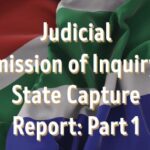This blog usually focuses on South African subjects because there are enough analysts and armchair commentators talking about the shitshow that is American politics at the moment. Be that as it may, I couldn’t stop myself from diving into the dataset of 2,973,371 tweets relating to Russian inteference recently released by the political statistics website, FiveThirtyEight.
These tweets were generated by 2,848 Twitter accounts associated with the Russian ‘troll’ farm known as the Internet Research Agency (IRA). The IRA sits at the centre of the storm around the alleged role of Russia in tipping the scales of the 2016 US elections. [UPDATE] The New York Times takes you inside how the IRA works here (video) and here.
I have a particular interest in political interference on social media given South Africa’s own experiences in this regards which I have written about extensively (for example, here, here and here). And yet, while our own politics have been irrevocably changed by the machinations of a few, the South African experience pales in comparison to what Americans have been subjected to. For example, Twitter recently told 1.4 million users that they had interacted with Russian ‘trolls’ and that was just the tip of the iceberg. US hearings into election interference heard that Russians ran over 3,000 adverts on Facebook and Instagram that promoted 120 different Facebook pages and reached 126 million Americans. And, let’s not even start on the Cambridge Analytica debacle [UPDATE] or the fact that interference efforts appear to be ongoing. Worst of all, the problem is global: a University of Oxford report found that at least 48 countries experienced coordinated social media manipulation campaigns in 2017.
…the problem is global: a University of Oxford report found that at least 48 countries experienced coordinated social media manipulation campaigns in 2017.
I think that there is a missing piece in the American discourse on trolls and fake news and that is around the concept of ‘sockpuppets‘. This is a term sorely missing from the American lexicon but it’s one that South Africans are all too familiar with. The term brings clarity to the discussion around Russia’s interference.
There’s a difference between a troll and a sockpuppet but the two are currently conflated in the debate about Russia’s interference in US politics. South Africans have experienced the power of sockpuppets first-hand when our former president, Jacob Zuma, worked with a powerful business family, the Guptas, to capture the state. They financed an India-based digital agency to create fake accounts from which to spread fake news. There’s no difference between what the Zuma-Gupta fake news machine did and what the IRA did (and likely continue to do) in American politics. Accounts created under fake identities that are designed to mislead are not troll accounts, they are sockpuppet accounts. This is a helpful distinction to make when distinguishing between real-world commentators that might be considered trolls, and sponsored accounts designed to push an agenda.
Indeed, the IRA sockpuppets’ actions on Twitter were not those of armchair commentators, nor was their commentary merely that of cynical or comedic Twitter users ‘trolling’ Americans in the 4chan sense of the word. Rather, their actions appear to be deliberate and coordinated. The researchers referenced in the FiveThirtyEight article point out that the temporal patterns of behaviour in the dataset imply that the IRA’s limited number of ‘workers’ rotated between the different accounts that they inhabited during the workday in order to mislead. This is not the behaviour of legitimate users, whether trolls or not. They are sockpuppets.
The data
The FiveThirtyEight dataset was actually created by Darren Linvill and Patrick Warren of Clemson University. They collated the dataset as part of a research project (here’s the working paper). They used lists of known Russian sockpuppet accounts and sourced all the tweets generated by those accounts. As such, the dataset relies on the completeness of those lists and they are undoubtedly incomplete, implying that there’s a lot more data still out there to analyse.
Linvill and Warren helpfully grouped the IRA sockpuppets accounts into the following categories: ‘left trolls [sockpuppets]’, ‘right trolls [sockpuppets]’, ‘hashtag gamers’, ‘fearmongers’, ‘commercial’, ‘timeline’, ‘non-English’ and ‘unknown’ . Here’s how the first few categories are described in the article:
- “Right Trolls behave like “bread-and-butter MAGA Americans, only all they do is talk about politics all day long,” Linvill said.”
- “Left Trolls often adopt the personae of Black Lives Matter activists, typically expressing support for Bernie Sanders and derision for Hillary Clinton, along with “clearly trying to divide the Democratic Party and lower voter turnout.””
- “News Feeds are a bit of a mystery: They present themselves as local news aggregators, with names such as @OnlineMemphis and @TodayPittsburgh, and the news they link to is typically legitimate.”
- “Hashtag Gamers specialize in playing hashtag games (e.g., #LessInterestingBooks might give rise to the tweet “Waldo’s Right Here”); many of their tweets are harmless wordplay in the spirit of the games, but some are socially divisive, in the style of Right Trolls or Left Trolls.”
- “[…] Fearmongers, relatively rare in the data set, spread news about a fake crisis, such as salmonella-contaminated turkeys around Thanksgiving, or the toxic chemical fumes described at the beginning of the New York Times Magazine article about the Internet Research Agency.”
The range of categories seems to imply that the IRA has interests outside of pure politics and, as we shall see, the politics-related activity in this dataset is really only consigned to one part of the interaction network below.
…the IRA has interests outside of pure politics… the politics-related activity in this dataset is really only consigned to one part of the interaction network…
Let’s take a look at some descriptive statistics around the overall dataset. Here’s a breakdown of the proportion of tweets falling into each category:
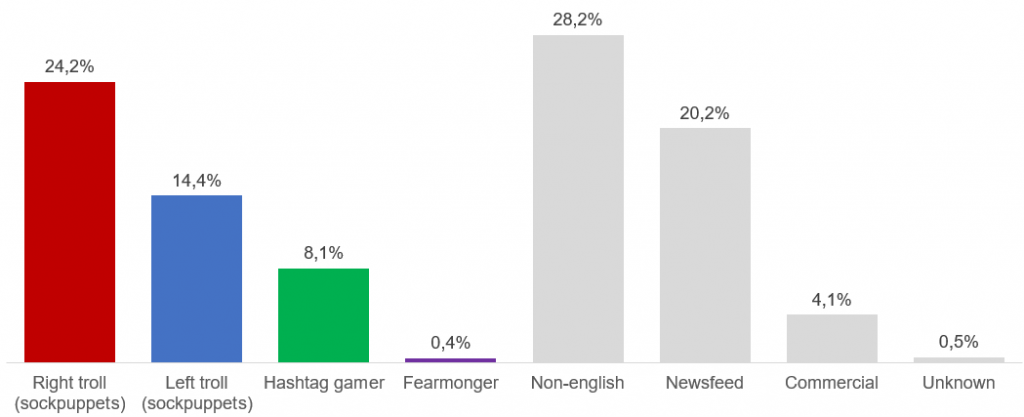
As we can see from the above, only 39% of the three million tweets were generated by sockpuppet accounts overtly focused on politics, perhaps pointing to the fact that the IRA has other interests outside of just politics. A US Intelligence Community report contends that the IRA’s “likely financier” has close ties to Putin and Russian Intelligence but this does not make it an explicit arm of the Russian government. Almost one in four tweets (24,2%) focused on Right-wing content, with the IRA generating 69% more content focused on the Right than the Left. In other words, they put most of their effort into affecting the Right’s narrative.
[The IRA] put most of their effort into affecting the Right’s narrative.
According to the FiveThirtyEight article, the strategy consisted of shoring up a pro-Trump narrative amongst the Right (although the sockpuppets initially supported Ted Cruz before switching to Trump), including by reinforcing populist fears around immigration and other Trump talking points, and splintering the Left to prevent it from posing realistic opposition to Trump. They splintered the Left in three primary ways:
- Raising race tensions by impersonating Black Lives Matter (BLM) activists. This appears to have been their primary tactic as the vast majority of their activity on the Left appears to have been focused on the BLM angle
- Undermining Hilary Clinton by pushing issues such as emails and illicit money flows
- Pushing Left supporters to Bernie Sanders
One might argue that they played both sides equally. If they chose Trump on the Right, didn’t they just choose Sanders on the Left? There are a couple observations that seem to undermine this theory though, including:
- As we’ve just seen above, they spent much more effort on generating Right-leaning content (68% more) and this content was all pro specific Republican candidates or reinforced fears aligned with those candidates’ talking points
- Not only was there less, although still substantial, Left-leaning content, but the vast majority of it focused on BLM rather than a political candidate. Clinton and Sanders content came a distant second and third after BLM content. Thus, Clinton and Sanders messaging did not receive the volume nor the focus that Trump messaging received
Isolating the sockpuppets
We can take the three million tweets and visualise them as an interaction network. This allows us to better understand who was interacting with whom, who the influencers were and who the distinct communities involved were.
To create an interaction network, we connect users that interact by retweeting or @mentioning each other. We then run a community detection clustering algorithm on the network to identify the distinct communities involved. Here’s what the network of offending accounts and all the others that they @mentioned or retweeted looks like:
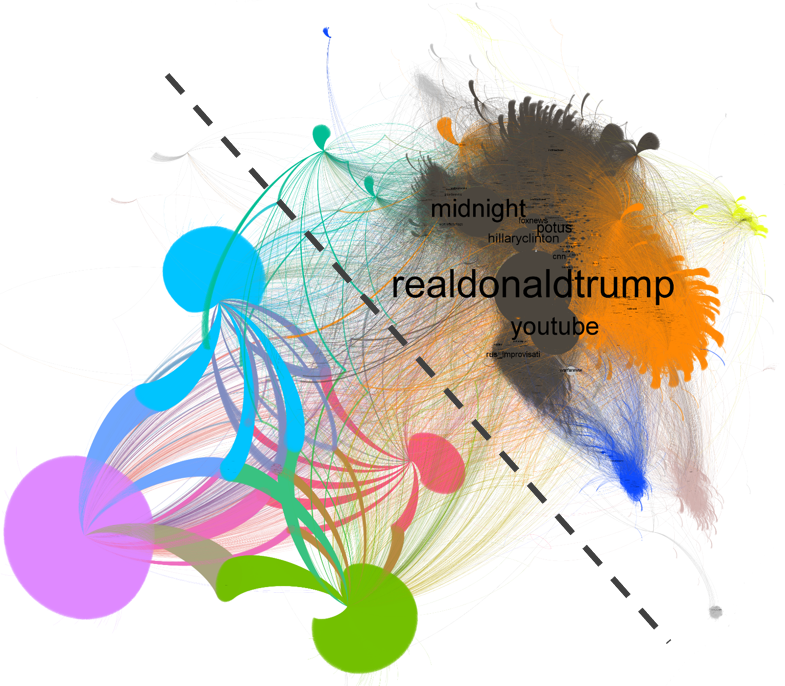
The above network consists of two halves. The left half is made up of seemingly innocuous IRA spam while the right half is where all the political discussions occurred. Again, this shows that the IRA focuses on more than just political conversations. For the remaining analyses, I’ve removed the spam accounts to focus instead on the political discussions. Removing the spam leaves the network looking like this:
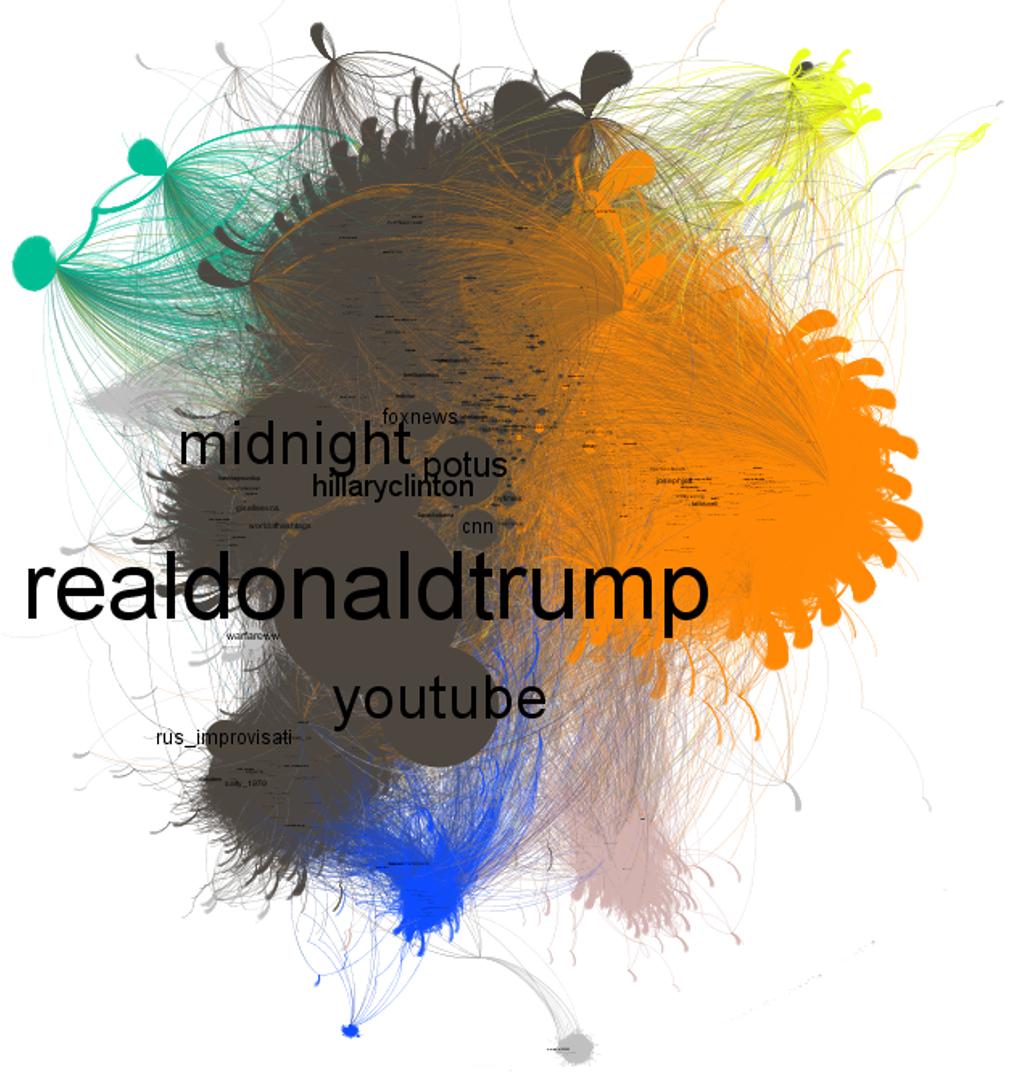
Interaction network of Russian sockpuppet accounts and those that they retweeted and @mentioned. Node size represents how often that user was @mentioned and retweeted.
The network above has two main components. Unsurprisingly, these represent the Left (orange) and Right (dark grey & turquoise) communities.
This split is confirmed when we take the network above and highlight the users that Linvill and Warren categorised as Left and Right ‘trolls’ (sockpuppets). As we can see, their footprints (i.e. the sockpuppets and the users that retweeted and @mentioned them) overlap with the communities just mentioned above:
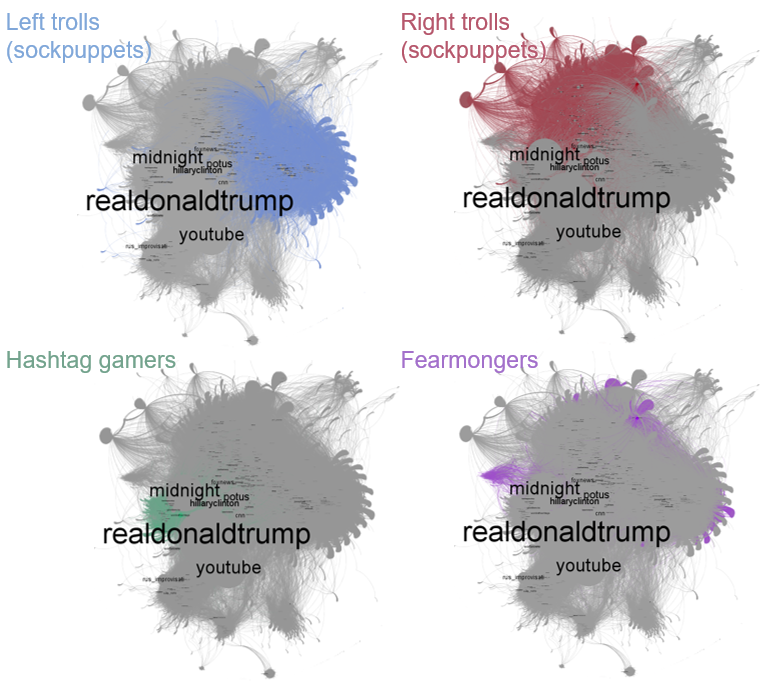
It’s interesting to see that @realdonaldtrump is the single most @mentioned and retweeted account in this network, again lending credence to the idea that he was the main focus of the IRA sockpuppets.
It’s also interesting to note the position of the ‘fearmongers’ community in purple on the periphery of both the Left and Right communities. According to Linvell and Warren, these accounts focused on spreading fake crises such as fake reports of disease outbreaks and chemical spills. Thus, these accounts appear to have worked to inject fear into both communities, perhaps making them more susceptible to the other sockpuppet communities’ messaging. The fact that they sit on the periphery of each community rather than dotted throughout those communities implies that they were not as tightly integrated into the broader political discussions as they could have been.
…[fearmonger] accounts appear to have worked to inject fear into both communities, perhaps making them more susceptible to the other sockpuppet communities’ messaging.
Finally for this section, it’s worth noting the prominent presence of @youtube in this dataset. The @youtube account is automatically included when users watch something on YouTube and share it on Twitter. This highlights the important role that video content played in the IRA strategy, which in turn touches on that platform’s own issues with fake news, conspiracy theories and hyper-partisan content, which I am not going to go into here.
The Left strategy
Let’s take a cursory look at the content strategies that the sockpuppets pushed.
Looking at the two sides, it’s almost clichéd the way in which the IRA sockpuppets played up stereotypes of the Left and Right, but then one does wonder to what extent these stereotypes existed before the IRA waded into the fray? Were these stereotypes hard-set in stone already or did the sockpuppets, at least partly, contribute to the creation of these stereotypes in the first place? If they did contribute, does that mean that our current conception of American politics and society was at least partly defined by Russian sockpuppets sitting in a nondescript Moscow office block?
…it’s almost clichéd the way in which the IRA sockpuppets played up stereotypes of the Left and Right, but then one does wonder to what extent these stereotypes existed before the IRA waded into the fray?
Let’s start by inspecting the Left-leaning hashtags used by the sockpuppets. Here are the top twenty:
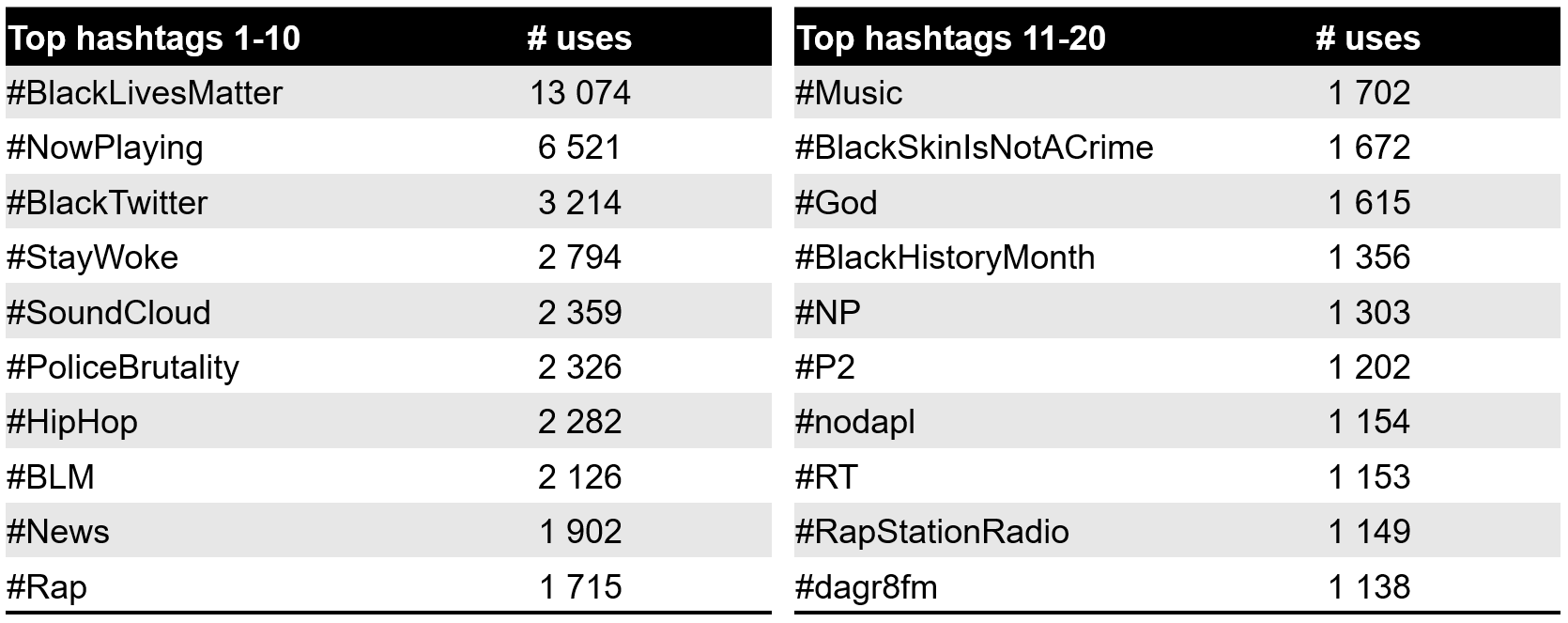
As we can see, the top Left hashtags were all about black consciousness, police violence and traditionally black music genres. I can’t help but feel angry about the cynical way they hijacked this community’s culture and grievances for their own ends. Will we ever know the extent to which perceptions around BLM today are based on real activists’ actions versus Russian interference? In addition, Russian interference raises questions about the potential knock-on influence that the sockpuppet campaign might have had in other countries, such as my own, South Africa, where BLM thinking played a major role in our recent chaotic social movements, Rhodes Must Fall and Fees Must Fall (see my articles on the latter movement here, here and here)?
Who were the sockpuppets @mentioning in their tweets in order to tap into those influencers’ communities and affect those influencers’ own perceptions? These users were @mentioned the most by the trolls:
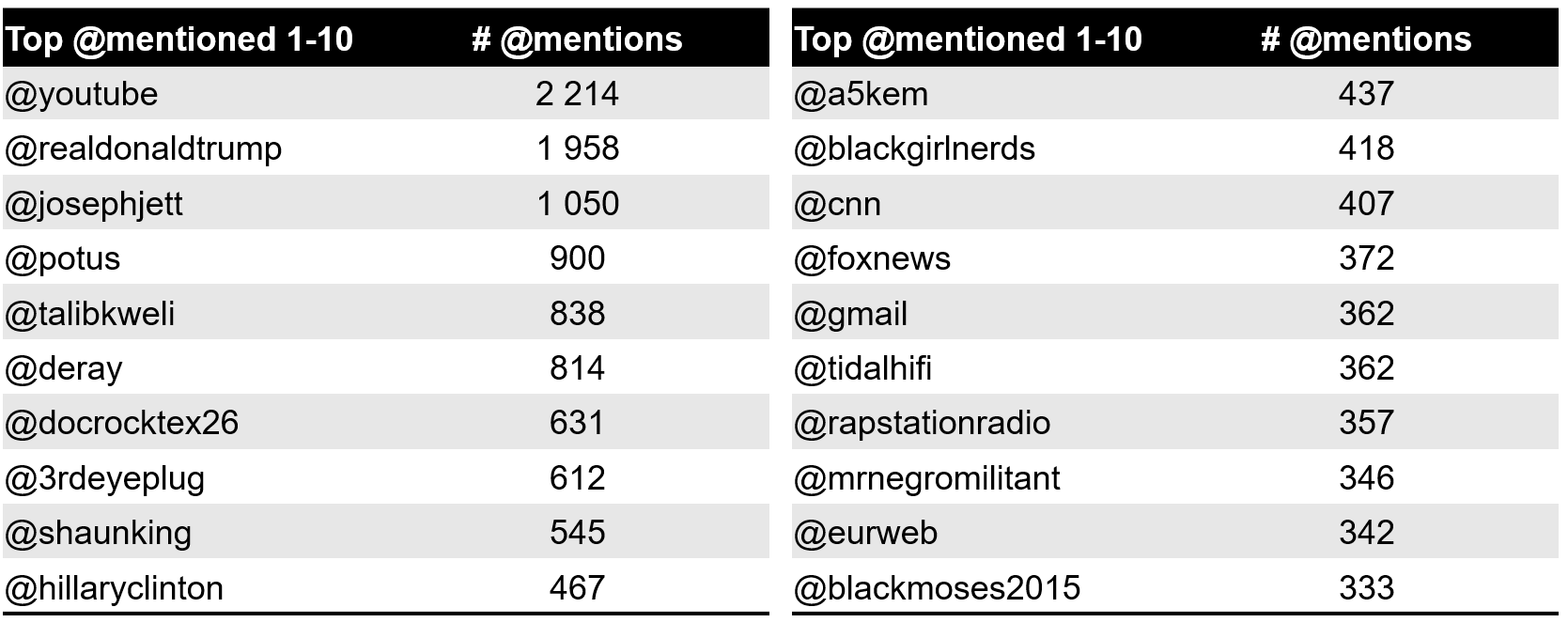
My lack of familiarity with all the specifics of American politics fails me here, but a few themes do stand out:
Most of the top-mentioned accounts were black influencers such as @josephjett, @talibkweli, @deray, etc. In addition, Hillary Clinton was mentioned, but not nearly as much as Donald Trump, and Bernie Sanders doesn’t even make this list, again undermining the idea that the sockpuppets were playing both sides equally. Given the mixture of Left and Right accounts, the @mentions seem to imply a pattern of support for Left accounts (e.g. @hillaryclinton and @cnn) and outrage manufacturing when it comes to Right accounts (e.g. @realdonaldtrump and @foxnews).
The Right strategy
Now let’s turn our attention to the content strategy used on the Right. Here are the top twenty Right hashtags:
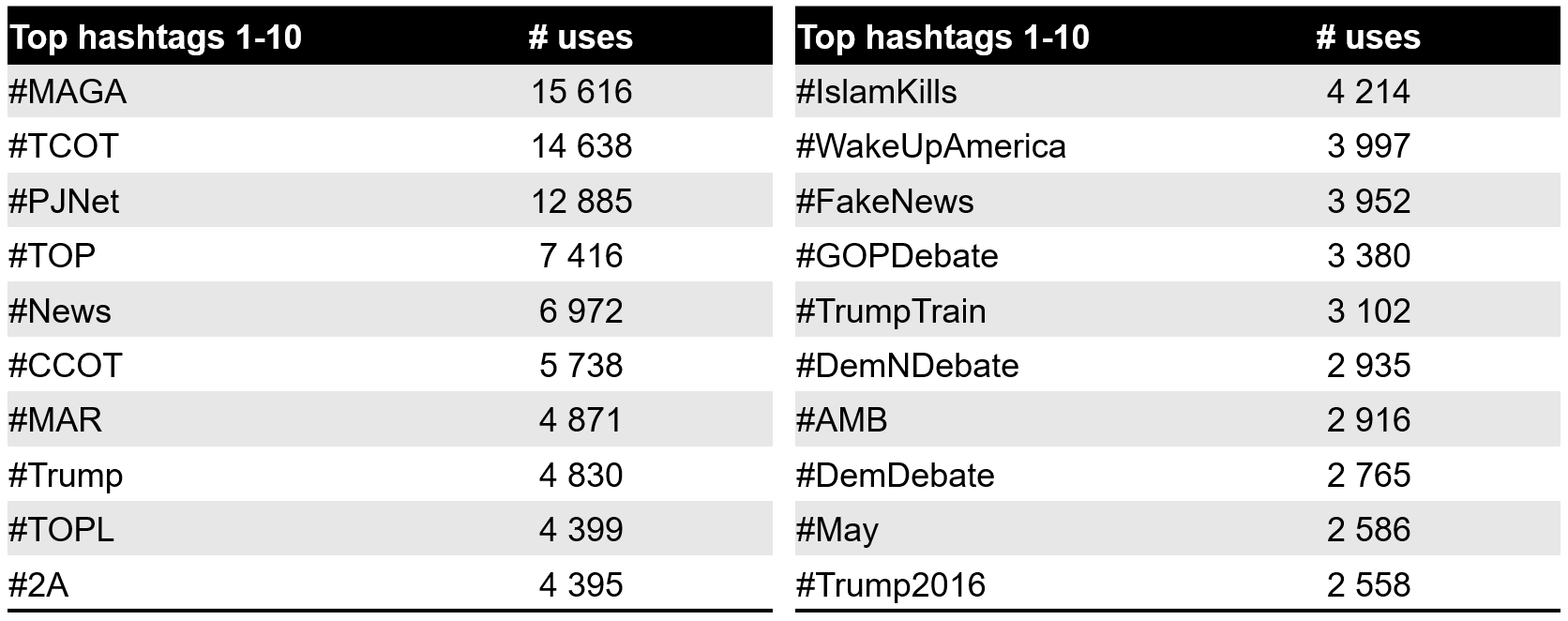
Unsurprisingly, the sockpuppets used all of the most well-known Right hashtags. I’m not too familiar with the specifics of Right hashtags on Twitter but most of these should appear familiar to American readers. Unsurprisingly at this point, the most popular used was Donald Trump’s tagline, “Make America Great Again” (#MAGA). Other well-known ones included #TCOT, #PJNet and #CCOT. Did the sockpuppet accounts hijack these already popular hashtags or did they have a hand in bootstrapping their popularity?
In addition to these partisan hashtags, two other topics were prevalent: enforcing fear of the other (#IslamKills) and the undermining of the media through the blanket claim of #FakeNews, which Trump popularised.
Now let’s dive into the users @mentioned the most by the Right sockpuppets:
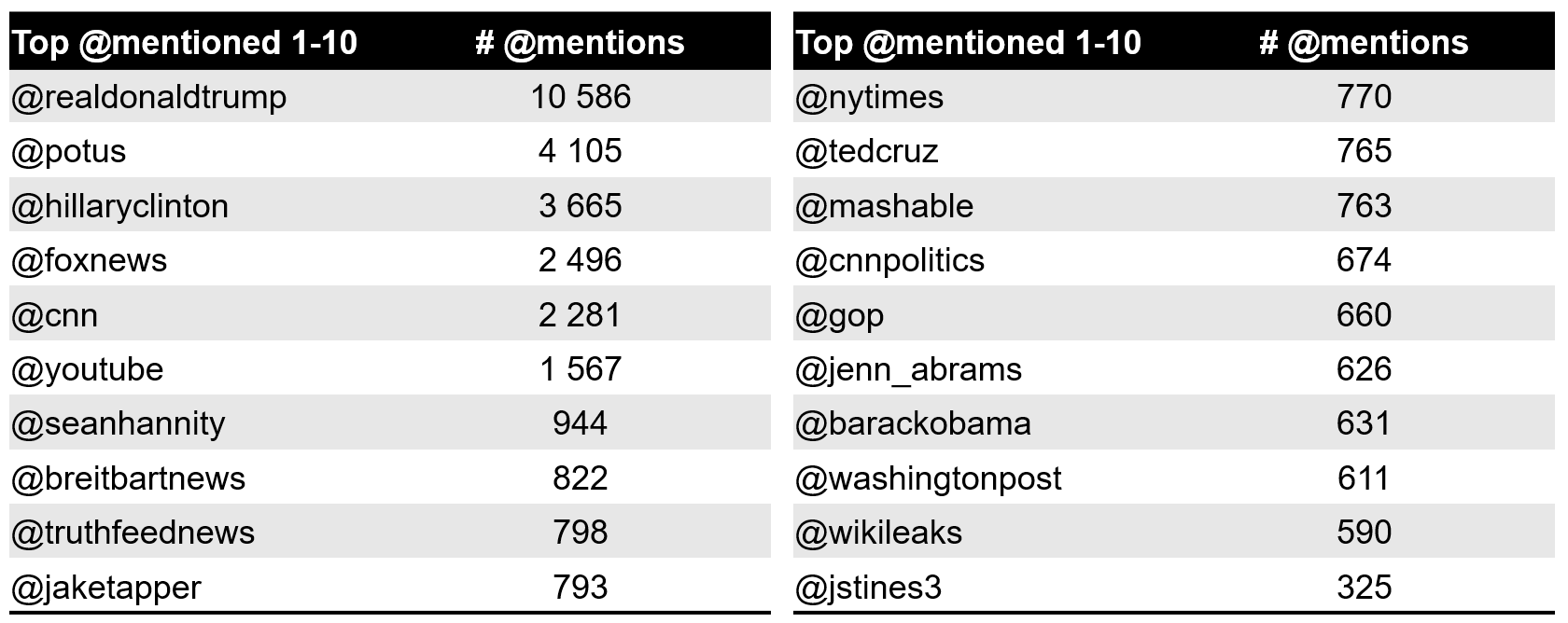
As we can see, it’s a whose-who of Right commentators, coupled with some of the Right’s favourite boogeymen including @cnn, @hillaryclinton, @nytimes, and @washingtonpost, which all feature surprisingly highly. It looks like the Right sockpuppets devoted as much time to pushing the Trump narrative in combination with news outlets such as @foxnews, @seanhannity and @breitbartnews, as they did to undermining other media outlets. There was definitely more of a focus on undermining trust in the media on the Right than on the Left.
Final comments
Sifting through this data has changed my perceptions on the nature of Russian interference in the 2016 US elections in a few ways. Using the distinction between trolls and sockpuppets has helped clarify these thoughts.
This data has brought home to me that the IRA is not simply an extension of the Russian government as I naively assumed it must be. Rather, it’s clear that they have interests beyond just politics. What it will come down to is the nature of the relationship, if any, between the IRA and the Russian government. Until this is clarified, these two groups will continue to be conflated, whether rightly or wrongly.
I also always assumed that the goal was to sow general dissent; to undermine a society and its geopolitical strength in the process. While the data shows that the IRA did play many angles, they did not play them equally. Indeed, they played them in a way that seems designed with one goal in mind: supporting Donald Trump. They focused the majority of their attention on building Right support for Trump while simultaneously working to fracture the Left so as to undermine its challenge to a Right candidate. I used to think that they supported their chosen candidates on the Left (Sanders) and Right (Trump) equally, but this is clearly not the case.
While the data shows that the IRA did play many angles, they did not play them equally. Indeed, they played them in a way that seems designed to support Donald Trump.
It’s deeply worrying that this kind of interference is likely to become more prevalent, not less. Trump escalated the arms race in this area just this month when he rescinded Obama-era laws restricting cyber weaponisation. This is particularly concerning for countries with imminent elections, like my own, South Africa (in 2019). Next stop, the outcome of the Mueller investigation…
Further reading
- United States Intelligence Community report: Assessing Russian Activities and Intentions in Recent US Elections
- UK House of Commons interim report: Disinformation and ‘fake news’
- Jonathan Albright’s The #Election2016 Micro-Propaganda Machine
- Some tantalizing research into the possible role of YouTube
- My research into political interference in South African politics via sockpuppet accounts
- ANCIR report on South African social media inteference: Manufacturing Divides: The Gupta-linked Radical Economic Transformation (RET) media network
- University of Oxford report on social media manipulation: Challenging Truth and Trust: a global inventory of organized social media manipulation
- Interference in the recent French elections: Disinformation and Social Bot Operations in the Run Up to the 2017 French Presidential Election





